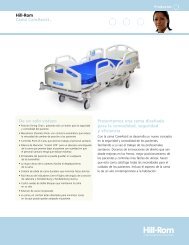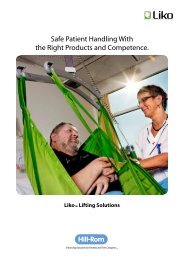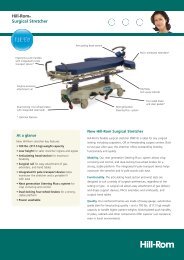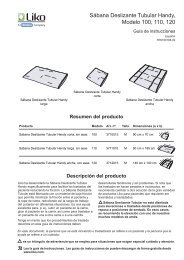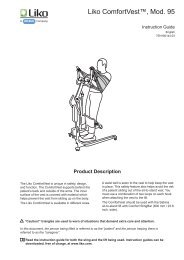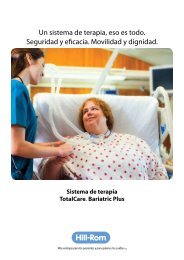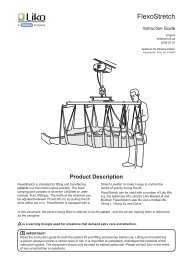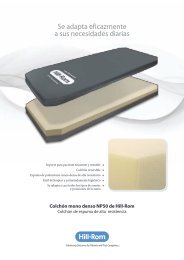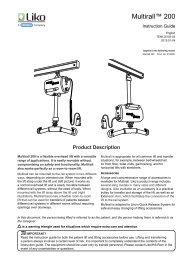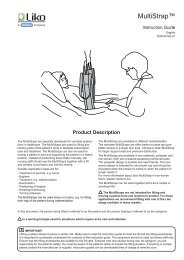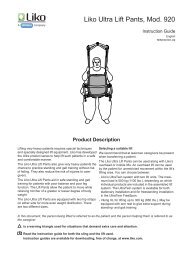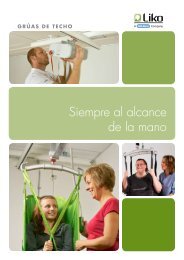Original HighBack Sling Instruction Guide EN - Liko
Original HighBack Sling Instruction Guide EN - Liko
Original HighBack Sling Instruction Guide EN - Liko
You also want an ePaper? Increase the reach of your titles
YUMPU automatically turns print PDFs into web optimized ePapers that Google loves.
<strong>Liko</strong> <strong>Original</strong> <strong>HighBack</strong> <strong>Sling</strong>, Mod. 20, 21<br />
<strong>Instruction</strong> <strong>Guide</strong><br />
English<br />
7<strong>EN</strong>160173-03<br />
Product Description<br />
<strong>Liko</strong> <strong>Original</strong> <strong>HighBack</strong> <strong>Sling</strong> is a basic model<br />
which is designed to adapt to the patient without<br />
individual adjustments and is one of our most<br />
used slings.<br />
It provides for a slightly semi-reclined sitting posture<br />
and excellent support for the entire body, which is good<br />
for patients with reduced torso stability. A properly<br />
fitted and carefully applied sling will give the patient<br />
an excellent sense of security, as well as a high degree<br />
of comfort.<br />
The <strong>Original</strong> <strong>HighBack</strong> <strong>Sling</strong> is also recommended<br />
for lifting to or from the floor, since it provides<br />
a comfortable head support both in sitting and in lying<br />
position.<br />
Sizes<br />
The <strong>Original</strong> <strong>HighBack</strong> <strong>Sling</strong> is available in different<br />
sizes. It is important to choose the correct size in order<br />
to achieve the highest level of comfort and safety.<br />
A sling which is too large increases the risk of the<br />
patient sliding out of it, while one which is too small<br />
can cut into the groin and cause discomfort.<br />
For larger sizes, a combination with <strong>Liko</strong> Universal<br />
TwinBar 670 can be a good choice.<br />
Fabrics<br />
The <strong>Original</strong> <strong>HighBack</strong> <strong>Sling</strong> is available in different<br />
fabrics. Since the <strong>Original</strong><strong>Sling</strong> is not usually left under<br />
the patient after a completed transfer, we recommend<br />
the polyester design. This fabric is durable and has<br />
low friction, making the sling easy to apply and easy<br />
to remove.<br />
The <strong>Original</strong> <strong>HighBack</strong> <strong>Sling</strong> is also available in net<br />
polyester. This fabric is recommended when the sling<br />
is left in place after the transfer or when an airier<br />
alternative is desired.<br />
For bathing and showering, a plastic-coated net design<br />
is available, which is water permeable and can easily<br />
be wiped. This material dries quickly and does not chill<br />
the patient in the same way as a damp, absorbent fabric<br />
would.<br />
The sling’s lift straps are always made of durable<br />
polyester and are very secure.<br />
Leg Supports<br />
The <strong>Original</strong> <strong>HighBack</strong> <strong>Sling</strong> is available with leg<br />
supports in different designs. Most common are<br />
reinforced leg supports. The reinforcement provides high<br />
comfort, distributes the pressure and prevents the sling<br />
from creasing under the thighs.<br />
One design has simple fabric without reinforcement in<br />
the leg support, making the sling more pliable and easy<br />
to care for.<br />
Finally there is also one design with soft-padded<br />
leg supports (synthetic sheepskin). This is suitable<br />
for especially pressure-sensitive patients.<br />
is a warning triangle used for situations which require extra care and attention.<br />
In this document, the person being lifted is referred to as the patient and the person helping is referred<br />
to as the caregiver.<br />
Read the instruction guide for both the sling and the lift being used. <strong>Instruction</strong> guides<br />
can be downloaded, free of charge, at www.liko.com.
Safety <strong>Instruction</strong>s<br />
Before lifting, keep the following points in mind:<br />
• A responsible person within your organization should decide on a case-by-case basis whether one or more<br />
caregivers are needed.<br />
• Ensure that the sling selected meets the patient’s needs with reference to model, size, fabric and design.<br />
• For safety and hygiene reasons, use individual slings.<br />
• Before lifting, plan the lifting operation so that it can be done as safely and smoothly as possible.<br />
• Before lifting, check that the lifting accessory hangs vertically and can move freely.<br />
• Although <strong>Liko</strong>’s sling bars are equipped with safety latches, special caution must be exercised: Before the patient<br />
is lifted from the underlying surface, but after the straps have been fully extended, make sure the straps<br />
are properly connected to the sling bar.<br />
• Make sure the patient is sitting securely in the sling before transferring to another location.<br />
• Never lift a patient higher off the underlying surface than is needed to complete the lifting and transfer procedure.<br />
• Never leave a patient unattended during a lifting situation.<br />
• Make sure that the wheels on the wheelchair, bed, gurney, etc., are locked during the lifting/transfer operation.<br />
• Always work ergonomically.<br />
Medical Device Class I<br />
<strong>Liko</strong> <strong>Original</strong> <strong>HighBack</strong> <strong>Sling</strong> has been tested by an accredited testing institute and complies with<br />
all requirements for MDD Class I products and the harmonized <strong>EN</strong> ISO 10535 standard.<br />
<strong>Liko</strong> is quality certified in accordance with ISO 9001 and its equivalent for the medical device industry,<br />
ISO 13485. <strong>Liko</strong> is also certified in accordance with environmental standard ISO 14001.<br />
Design and Quality by <strong>Liko</strong> in Sweden<br />
<strong>Liko</strong>’s products undergo continuous development, which is why we reserve the right to make product changes<br />
without prior notice. Contact your <strong>Liko</strong>/Hill-Rom representative for advice and information about product upgrades.<br />
IMPORTANT!<br />
Lifting and transferring a patient always involves a certain risk. Read the instruction guide for both the lift and<br />
lifting accessories before use. It is important to completely understand the contents of the instruction guide.<br />
The equipment should only be used by trained personnel. Ensure that the lifting accessories are suitable<br />
for the lift being used. Exercise care and caution during use. As a caregiver, you are always responsible<br />
for the patient’s safety. You must be aware of the patient’s ability to handle the lifting situation.<br />
Care and Maintenance<br />
Check the sling before each use. Check the following points with regard to wear and damage:<br />
• Fabric<br />
• Straps<br />
• Seams<br />
• Suspension loops<br />
Do not use damaged lifting accessories.<br />
If anything is unclear, please contact the manufacturer or supplier.<br />
Washing instructions: See the sling’s product label.<br />
Expected Life Time<br />
The product has an expected life time of 1-5 years during normal use. Expected life time varies depending on<br />
fabric, use frequency, washing procedure, and weight carried.<br />
Periodic Inspection<br />
The product must be inspected at least once every 6 months. More frequent inspections might be required if the<br />
products are used or washed more often than normal. See <strong>Liko</strong>’s protocol Periodic Inspection for the respective<br />
product.<br />
<strong>Liko</strong> <strong>Original</strong> <strong>HighBack</strong> <strong>Sling</strong> • 7<strong>EN</strong>160173-03<br />
<br />
www.liko.com
Definitions<br />
1 2 3 4<br />
5<br />
6<br />
7<br />
8<br />
9<br />
10<br />
11<br />
12<br />
13<br />
1. Serial number<br />
2. Product label<br />
3. Label: Periodic Inspection<br />
4. Label: Individual marking (Belongs to)<br />
5. Upper strap loop<br />
6. Head support with laths<br />
7. Center back strap / Size marking<br />
8. Belt (where applicable)<br />
9. Handle<br />
10. Lower edge<br />
11. Leg support<br />
12. Shortening position<br />
13. Leg support loop<br />
Lifting from a Sitting Position<br />
Two caregivers should be used to place the sling in accordance with ergonomic principles. The patient is usually<br />
tilted forward during the application, and it is then important that a caregiver stand in front of the patient to prevent<br />
him/her from falling forwards.<br />
Place the sling behind the patient’s back with<br />
the product label outwards. Fold up the lower edge<br />
of the sling around your finger tips to facilitate guiding<br />
the sling into place.<br />
Using the palm of your hand, push the lower<br />
edge of the sling down to the level of the patient’s<br />
coccyx -this is very important. Tip: Correct<br />
positioning is facilitated if the patient leans/is leaned<br />
forward slightly.<br />
Pull the sling’s leg supports forward along the outside<br />
of the patient’s thighs. Place the palm of your hand<br />
between the patient’s body and the sling and push<br />
the leg support’s lower edge down towards the seat.<br />
Simultaneously, pull the leg support forward with<br />
the other hand to stretch it.<br />
Pull the leg supports forward to smooth out any<br />
creases in the back. Check that both leg supports<br />
protrude the same distance. Tip: A gentle hold under<br />
the knee-cap makes it easier to pull the leg supports<br />
forward.<br />
<strong>Liko</strong> <strong>Original</strong> <strong>HighBack</strong> <strong>Sling</strong> • 7<strong>EN</strong>160173-03<br />
<br />
www.liko.com
Insert one leg support under each thigh. Make sure<br />
the fabric lies flat and that it reaches properly around<br />
the leg. Tip: The application of the leg supports<br />
is facilitated if the patient’s legs are slightly raised from<br />
the seat. This can be achieved by placing the patient’s<br />
feet on the foot-rests or on your own leg, as illustrated.<br />
Prepare the connection of the leg supports. The most<br />
common way of applying the sling is with crossed<br />
leg supports. For alternative methods, see page 8.<br />
Tip: Check that all suspension loops have the same<br />
length, i.e., are at an equal height when they are<br />
stretched prior to lifting. Adjust the position of the sling<br />
if they are not at an equal height.<br />
Lifting to a Sitting Position<br />
First connect the upper strap loops to the sling bar,<br />
then the leg support loops. Lift.<br />
When placing a patient in a wheelchair, it is important that the patient gets far enough back in the chair<br />
to sit well. This can be accomplished in several ways.<br />
When placing a patient in a wheelchair:<br />
Lean the chair backwards during the lowering<br />
of the patient. Let the buttocks slide down<br />
the backrest during the last part. Control<br />
the angle of the wheelchair with your foot<br />
on the tipping support.<br />
Alternative: Apply slight pressure under the patient’s<br />
knees during the lowering sequence, so that<br />
the buttocks are guided towards the backrest<br />
of the chair. If the sling has handles, these can<br />
be used to guide.<br />
Do not use the handles to lift! Excessive force<br />
on the handles can cause the sling to tear.<br />
<strong>Liko</strong> <strong>Original</strong> <strong>HighBack</strong> <strong>Sling</strong> • 7<strong>EN</strong>160173-03<br />
<br />
www.liko.com
Removing the <strong>Sling</strong> in a Chair/Wheelchair<br />
We recommend removing the sling after the transfer. If for some reason it is preferable to leave the sling<br />
in the chair, we recommend using a sling made of net polyester.<br />
Carefully remove the leg support. The gentlest way<br />
of doing this is by pulling out the leg support loops<br />
under the fabric part of the leg support.<br />
Lifting from the Bed<br />
Remove the sling by carefully pulling it up.<br />
We recommend applying the sling when the patient is lying horizontally, as this is the easiest procedure. In some<br />
cases, e.g., if the patient cannot lie horizontally, the sling can be applied with the patient sitting up in bed<br />
(see “Alternative method of applying the sling” below).<br />
Think about your own work posture as well as the comfort of the patient. Use the bed’s raising and lowering<br />
functions.<br />
Turn the patient toward you<br />
to prevent him or her from falling out<br />
of the bed. Insert the sling’s edge<br />
under the patient with the lower edge<br />
level with the coccyx. Fold the<br />
sling so that its centre back strap<br />
corresponds to the patient’s spine<br />
when the patient is turned back again<br />
gently. Carefully pull the sling out<br />
from the other side.<br />
Insert the leg supports under<br />
the legs. This is best done<br />
by pressing the leg support<br />
down against the mattress while<br />
inserting it under the thigh. Make<br />
sure the fabric lies flat and that<br />
it reaches properly around the leg.<br />
The leg supports can be connected<br />
in different ways, see page 8.<br />
Raise the head end of the bed.<br />
First connect the upper strap<br />
loops to the sling bar, then<br />
the leg support loops. Lift.<br />
Alternative method of applying the sling: Raise the head end of the bed behind the patient. Lay the sling<br />
on the bed with the product label facing down towards the mattress. Slide the sling down behind the patient’s<br />
back so that the lower edge is level with the coccyx. Tip! The application is facilitated if the patient leans/is<br />
leaned forward.<br />
<strong>Liko</strong> <strong>Original</strong> <strong>HighBack</strong> <strong>Sling</strong> • 7<strong>EN</strong>160173-03<br />
<br />
www.liko.com
Lifting to the Bed<br />
We recommend removing the sling after transfer. If for some reason it is preferable to leave the sling<br />
in the bed after transfer, we recommend using a sling made of net polyester.<br />
Think about your own work posture as well as the comfort of the patient. Use the bed’s raising and lowering<br />
functions.<br />
Removing the <strong>Sling</strong> when the Patient is Sitting in Bed<br />
Position the patient above the bed.<br />
Raise the head end of the bed<br />
for the patient’s comfort. Lower<br />
the patient onto the bed.<br />
Remove the leg supports by pulling<br />
out the leg support loops under<br />
the fabric part of the leg support.<br />
Tip: This is facilitated if thepatient’s<br />
legs are bent.<br />
Remove the sling by carefully<br />
pulling it up.<br />
Removing the <strong>Sling</strong> when the Patient is Lying in Bed<br />
Position the patient above the bed. Raise the head<br />
end of the bed for the patient’s comfort. Lower<br />
the patient onto the bed. Lower the head end.<br />
Place the leg support loops under the leg supports<br />
between the patient’s legs.<br />
Grasp the edge of the sling. Push in the sling under<br />
itself. Press the sling against the mattress and<br />
in under the patient.<br />
Carefully turn the patient onto the side. Grasp<br />
the sling from below and remove it carefully.<br />
<strong>Liko</strong> <strong>Original</strong> <strong>HighBack</strong> <strong>Sling</strong> • 7<strong>EN</strong>160173-03<br />
<br />
www.liko.com
Lifting from the Floor<br />
Lifting from the floor with <strong>Liko</strong>’s mobile lift Golvo is described below. The same technique is suitable also for lifting<br />
with <strong>Liko</strong>’s other mobile and stationary lifts. Read the <strong>Instruction</strong> <strong>Guide</strong> for the lift being used.<br />
Tip: A pillow under the patient’s head could be comfortable.<br />
Carefully turn the patient onto the side and place<br />
the sling’s edge under the patient with the lower edge<br />
level with the coccyx. Fold the sling so that its centre<br />
back strap corresponds to the patient’s spine when<br />
the patient is turned back again gently. Carefully pull<br />
the sling out from the other side.<br />
Check that the sling lies symmetrically under the patient;<br />
adjust the position if necessary.<br />
Place the leg supports under the legs.<br />
Smooth out the leg supports under the patient’s legs. Keep<br />
the leg supports away from the groin to prevent discomfort to<br />
the patient. This is facilitated if the patient bends the legs.<br />
The mobile lift should be locked when lifting with<br />
the patient’s head against the lift.<br />
Lift the patient from the floor. The patient can<br />
be rotated slightly to avoid the head’s getting<br />
to close to the mast.<br />
Lifting to the Floor<br />
When lifting to the floor, the wheels of the lift should not be locked. When the patient touches the floor, the lift<br />
should be pulled backwards to give space for the head. Tip: If lifting is to a thinner gym mat, the lift can be pushed<br />
in under this mat, so that the mat acts as a soft protection between the lift and the patient. If the sling is to be<br />
removed, see ”Removing the <strong>Sling</strong> when the Patient is Lying in Bed”, page 6.<br />
<strong>Liko</strong> <strong>Original</strong> <strong>HighBack</strong> <strong>Sling</strong> • 7<strong>EN</strong>160173-03<br />
<br />
www.liko.com
Fitting Advice<br />
Different Sitting Positions<br />
A. B.<br />
<strong>Liko</strong> <strong>Original</strong> <strong>HighBack</strong> <strong>Sling</strong> in<br />
two-point suspension provides<br />
for a slightly reclined sitting posture<br />
with excellent head support and<br />
approx. 90 degrees angle<br />
in the hip joint.<br />
<strong>Liko</strong> <strong>Original</strong> <strong>HighBack</strong> <strong>Sling</strong> in<br />
combination with the Universal<br />
TwinBar 670 provides larger width<br />
at the shoulders than at the leg<br />
supports, which is suitable<br />
if the patient is large or sensitive<br />
to pressure to the shoulders.<br />
A. In combination with <strong>Liko</strong> Cross-bar<br />
a slightly more reclined posture and<br />
a larger angle is obtained. Complete<br />
with a small pillow behind the head.<br />
B. In combination with SideBars<br />
a slightly more reclined posture and<br />
a larger width at the shoulders than<br />
at the leg supports is provided, which<br />
is suitable if the patient is sensitive<br />
to pressure to the shoulders.<br />
Different Ways of Connecting Leg Supports<br />
Before a connection alternative is chosen, an individual assessment should be performed to anticipate possible risks.<br />
The following are general advice since the same principles are valid for several sling models.<br />
Crossed-over leg supports.<br />
The most common way of applying<br />
the sling. One leg support loop<br />
is passed through the other before<br />
the loops are connected to the sling<br />
bar.<br />
Overlapped under both thighs.<br />
This can be appropriate, for<br />
example, when lifting a patient with<br />
amputated legs. Tip: In order to avoid<br />
the patient’s sitting posture being<br />
too reclined, Extension Loops can<br />
be attached to the leg support loops.<br />
Each leg support connected<br />
separately to the sling bar.<br />
This can be appropriate when<br />
lifting patients with particularly<br />
sensitive genitals.<br />
Increased risk of sliding out.<br />
<strong>Liko</strong> <strong>Original</strong> <strong>HighBack</strong> <strong>Sling</strong> • 7<strong>EN</strong>160173-03<br />
<br />
www.liko.com
The Patient does not Sit Well in the <strong>Sling</strong> – Why is This?<br />
The following are general advice since the same principles are valid for several sling models.<br />
WRONG!<br />
RIGHT!<br />
A. B.<br />
A. Risk of sliding out. The buttocks hang down. The sling<br />
may be too large. It can also be due to the fact that<br />
the sling has not been pulled down the patient’s back<br />
sufficiently.<br />
Before lifting, check that the lower edge is stretched<br />
and that the fabric reaches properly around the legs.<br />
B. A sling that is too small can cause the leg supports to<br />
cut into the groin, causing discomfort, and the sling bar to<br />
be too close to the face and/or the back to get insufficient<br />
support.<br />
The lower edge of the sling is at the same<br />
level as the coccyx. The leg supports<br />
are properly positioned under the legs.<br />
Shortening Position<br />
In certain cases, it can be advantageous to shorten the leg support loop for the patient to sit well in the<br />
<strong>Original</strong> <strong>HighBack</strong> <strong>Sling</strong>. The shortening position can be used temporarily in order to test for the right length,<br />
but extended use may damage the bartacks. However, if you want to shorten the leg support loop for long term<br />
use, we recommend that you tie a knot in the loop to shorten it about 10 cm (4 in). In this case, it is the outer<br />
leg support loop which should be connected to the sling bar.<br />
<strong>Liko</strong> <strong>Original</strong> <strong>HighBack</strong> <strong>Sling</strong> • 7<strong>EN</strong>160173-03<br />
<br />
www.liko.com
Combinations<br />
Overview <strong>Liko</strong> <strong>Original</strong> <strong>HighBack</strong> <strong>Sling</strong>, Mod 20, 21<br />
Product Prod. No. Size Patient’s Weight¹ Max. Load²<br />
<strong>Original</strong> <strong>HighBack</strong> <strong>Sling</strong> 3520 - - 2³ XXS Extra Extra Small -15 kg (33 lbs) 200 kg (440 lbs)<br />
<strong>Original</strong> <strong>HighBack</strong> <strong>Sling</strong> 3520 - - 3 XS Extra Small 15-20 kg (33-44 lbs) 200 kg (440 lbs)<br />
<strong>Original</strong> <strong>HighBack</strong> <strong>Sling</strong> 3520 - - 4 S Small (child) 20-30 kg (44-66 lbs) 200 kg (440 lbs)<br />
<strong>Original</strong> <strong>HighBack</strong> <strong>Sling</strong> 3521 - - 5 MS Medium Slim (slim adult) 30-50 kg (66-110 lbs) 200 kg (440 lbs)<br />
<strong>Original</strong> <strong>HighBack</strong> <strong>Sling</strong> 3520 - - 5 M Medium 40-80 kg (88-176 lbs) 200 kg (440 lbs)<br />
<strong>Original</strong> <strong>HighBack</strong> <strong>Sling</strong> 3520 - - 6 L Large 70-120 kg (154-264 lbs) 200 kg (440 lbs)<br />
<strong>Original</strong> <strong>HighBack</strong> <strong>Sling</strong> 3520 - - 7 XL Extra Large 110-250 kg (242-550 lbs) 500 kg (1,100 lbs)<br />
<strong>Original</strong> <strong>HighBack</strong> <strong>Sling</strong> 3520 - - 8 XXL Extra Extra Large 200- kg (440- lbs) 500 kg (1,100 lbs)<br />
¹ The indicated patient weight is only a guideline – there may be deviations.<br />
² For retained maximum load, lift/accessories intended for the same load or more are required.<br />
³ Made to order sling.<br />
352- - - 5 Indicates size<br />
1 Polyester 3 Net polyester 4 Plastic-coated net<br />
0 Without reinforcement or padding<br />
1 Reinforced leg supports<br />
2 Leg supports padded with synthetic sheepskin<br />
Indicates sling model<br />
Recommended combinations<br />
of the <strong>Liko</strong> <strong>Original</strong> <strong>HighBack</strong> <strong>Sling</strong><br />
and <strong>Liko</strong>’s sling bars:<br />
<strong>Sling</strong>Bar Mini 220<br />
Explanation: 1 = Recommended, 2 = May work, 3 = Not advised, 4 = Inappropriate<br />
* May cause premature wearing of the sling.<br />
Slim 350<br />
Universal 350<br />
Standard 450<br />
<strong>Original</strong> <strong>HighBack</strong> <strong>Sling</strong>, XXS 2 1 1 1 1 4 3 3 2 2 3 2 2 2 2<br />
<strong>Original</strong> <strong>HighBack</strong> <strong>Sling</strong>, XS 2 1 1 1 1 4 3 3 1 1 3 2 1 2 1<br />
<strong>Original</strong> <strong>HighBack</strong> <strong>Sling</strong>, S 2 1 1 1 1 3* 3 3 1 1 3 2 1 2 1<br />
<strong>Original</strong> <strong>HighBack</strong> <strong>Sling</strong>, MS 3 2 2 1 1 3* 3 2 1 1 1 2 1 2 1<br />
<strong>Original</strong> <strong>HighBack</strong> <strong>Sling</strong>, M 3 2 2 1 1 3* 1 1 1 1 1 2 1 1 1<br />
<strong>Original</strong> <strong>HighBack</strong> <strong>Sling</strong>, L 3 3 3 1 1 3* 1 1 1 2 1 2 1 1 1<br />
<strong>Original</strong> <strong>HighBack</strong> <strong>Sling</strong>, XL 4 3 3 2 1 3* 1 1 2 2 1 3 2 1 1<br />
<strong>Original</strong> <strong>HighBack</strong> <strong>Sling</strong>, XXL 4 4 4 4 3 3* 2 2 2 4 1 4 4 2 2<br />
Universal 450<br />
Universal 600<br />
Wide 670<br />
Univ. TwinBar 670<br />
Cross-bar<br />
<strong>Sling</strong> Cross-bar 450<br />
<strong>Sling</strong> Cross-bar 670<br />
SideBars +<br />
Slim 350<br />
Univ. SideBars +<br />
Universal 350<br />
SideBars +<br />
Standard 450<br />
Univ. SideBars +<br />
Universal 450<br />
© Copyright <strong>Liko</strong> AB 2011-05<br />
Other Combinations<br />
Combinations of accessories/products other than those recommended by <strong>Liko</strong> can result in risks for the safety<br />
of the patient.<br />
In those cases where another manufacturer recommends <strong>Liko</strong>’s accessories/products in combination with their<br />
or others’ accessories/products, and the combinations are not approved by <strong>Liko</strong>, that manufacturer assumes<br />
the responsibility for that combination. <strong>Liko</strong> then refers to the responsible manufacturer’s instruction guides<br />
and recommendations concerning usage, maintenance, cleaning, checking and inspection of the combination<br />
in order to fulfil the <strong>EN</strong> ISO 10535 requirements.<br />
www.liko.com<br />
Manufacturer:<br />
<strong>Liko</strong> AB<br />
SE-975 92 Luleå<br />
Sweden<br />
info@liko.se



